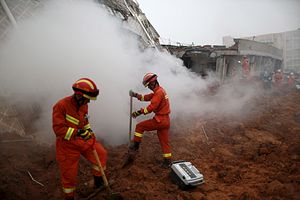A landslide in a southern Chinese city buried 33 buildings, leaving 85 people unaccounted for as of Monday evening, according to Xinhua. The incident occurred in an industrial park when construction waste spilled down a hill from a nearby dump site. According to Shenzhen’s deputy mayor, Liu Qingsheng, the landslide left 380,000 square meters buried under 10 meters of mud.
One survivor told Xinhua that the mud had come toward the factory where she was working “like sea waves.” “I felt I would have been engulfed in it if I were just one second late,” she said.
The government rushed rescue workers to Shenzhen’s Guangming New District, with just under 3,000 (including 800 members of China’s armed forces) on the scene by Monday. Despite those efforts, only seven people had been rescued nearly 36 hours after the landslide occurred at 11:30 AM local time on Sunday. One rescue worker acknowledged to Xinhua that the rescue operations were “extremely difficult,” with mud pouring in to fill up excavation sites.
Sixteen people remained hospitalized, though Xinhua reported all were in stable condition. In total, around 900 people had been evacuated from the site.
In addition, a natural gas pipeline burst due to the landslide, cutting off supplies to neighboring Hong Kong. China National Petroleum Corp., the parent of PetroChinaCo., the operator of the pipeline, said it had emptied the affected section of the West-East pipeline, which carries gas from Central Asia to Shenzhen, Hong Kong, and other locations in eastern China. CNPC said workers would begin constructing a temporary replacement pipeline on Tuesday, which should take seven to ten days to complete.
Media outlets have already begun digging into the construction waste dump that caused the landslide. South China Morning Post reports that the dump was ordered to close and improve safety conditions five months ago, but apparently that order was simply ignored. The Hongao Construction Waste Dump was originally approved to operate only from February 2014 to February 2015 – but a government inspection in July of this year found that the site was still accepting waste. Worse, it was reportedly not following the approved safety plans. The company was ordered to improve its operations and reapply for a license in September; it apparently did neither.
China’s Ministry of Land and Resources said that the dump had piled up 20 stories’ worth of earth and rubble before the site collapsed into the massive landslide on Sunday. According to SCMP, residents had complained to the local government about the dump, which visually appeared unstable.
Chinese Premier Li Keqiang has already ordered an official investigation into the incident. If another recent industrial accident is any precedent, proverbial heads are going to roll.
After two explosions at a chemical warehouse in Tianjin killed 165 people this August, China’s central government also ordered an investigation into the blasts. While the findings have yet to be publicly released, Chinese state media reported that the investigation found “irregularities and illegal operations by the companies involved, and acts of corruption and dereliction of duty on the part of relevant departments.” Just after the explosions, Chinese media outlets reported that the chemical warehouse was built too close to residential warehouses, in violation of relevant safety regulations, and was only able to pass inspections due to the company’s political connections. Within three weeks of the Tianjin explosions, 12 executives and safety inspectors had been arrested, and another 11 government officials were being investigated for their roles in the fatal accident.
The Tianjin explosions sparked a wave of promises about a government campaign to improve industrial safety in China. The Shenzhen landslide is a tragic reminder that the campaign has a long way to go, particularly when it comes to ensuring compliance at the local level.

































